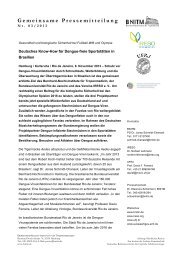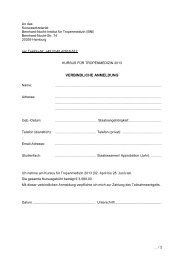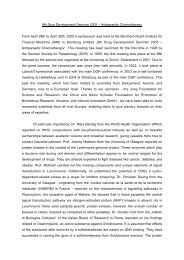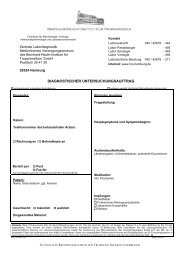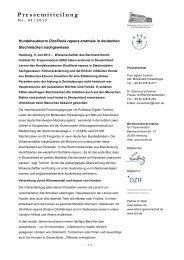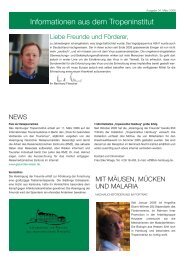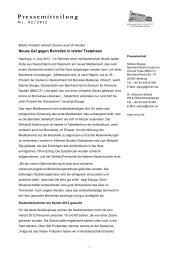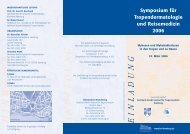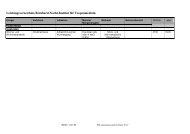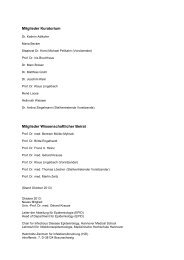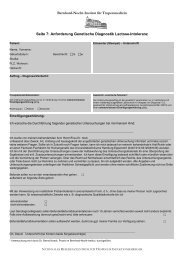Research Group Heussler (Malaria I) - Bernhard-Nocht-Institut für ...
Research Group Heussler (Malaria I) - Bernhard-Nocht-Institut für ...
Research Group Heussler (Malaria I) - Bernhard-Nocht-Institut für ...
Create successful ePaper yourself
Turn your PDF publications into a flip-book with our unique Google optimized e-Paper software.
Medical Microbiology Section<br />
Zusammenfassung<br />
T-Zellen spielen eine entscheidende Rolle bei der<br />
Bekämpfung der <strong>Malaria</strong> und sind sowohl an der<br />
Kontrolle der Leberstadien, als auch an der Kontrolle<br />
der Blutstadien beteiligt. Eine Aktivierung von T-Zellen<br />
während der Leberphase induziert keine Pathologie,<br />
wodurch diese Phase in der Regel ohne Symptome<br />
verläuft. Im Gegensatz dazu wird die Blutphase<br />
von der charakteristischen Symptomatik der<br />
<strong>Malaria</strong> und der damit verbundenen Pathologie begleitet.<br />
Eine Schlüsselstellung bei der Pathogenese<br />
nehmen dabei T-Zellen ein. Insbesondere Th1-Zellen<br />
und die damit assoziierten Zytokine IFN-γ und TNF-α<br />
scheinen ursächlich an der Pathologie der schweren<br />
<strong>Malaria</strong> beteiligt zu sein. Aus früheren Arbeiten wissen<br />
wir, dass CTLA-4 (CD152) an der Kontrolle der<br />
T-Zellen beteiligt ist. Dieses Molekül ist ein negativer<br />
Regulator auf der Oberfläche von aktivierten T-Zellen<br />
und wird im Verlauf der <strong>Malaria</strong> induziert. Eine<br />
Blockade dieses Moleküls in einem Mausmodell der<br />
<strong>Malaria</strong> führt zwar zu einer verstärkten Aktivierung<br />
von T-Zellen, aber induziert gleichzeitig eine Pathologie<br />
in verschiedenen Organen. Unsere Untersuchungen<br />
haben gezeigt, dass die Expression von CTLA-4<br />
zu einer Kontrolle von T-Zellen in verschiedene Geweben<br />
führen kann und dadurch das Ausmaß der<br />
Entzündung kontrolliert wird.<br />
CTLA-4 dependent regulation<br />
of T cells during <strong>Malaria</strong><br />
52<br />
Summary<br />
T cells were shown to play an important role in the control<br />
of malaria during the liver stage as well as during<br />
the blood stage of the disease. An activation of T cells<br />
during the liver phase is not associated with any symptoms,<br />
whereas an activation of T cells during the blood<br />
stage contribute to the typical symptoms of malaria.<br />
T cells were shown to play a key role in the development<br />
of pathology. Especially Th1 cells and their characteristic<br />
cytokines IFN-γ and TNF-α were shown to be<br />
involved in pathology. Recently it was shown that CTLA-<br />
4 (CD152) could regulate the function of T cells. This<br />
molecule expressed on the surface of activated T cells<br />
and its expression is induced during malaria. A blockade<br />
of this molecule leads to an increased activation of<br />
T cells but was also accompanied by a severe pathology<br />
in various organs. Our studies have shown that an<br />
expression of CTLA-4 leads to a control of T cells in peripheral<br />
tissues and thus providing a mechanism by<br />
which inflammation could be controlled.<br />
Introduction<br />
T cells play a key role in the control of various<br />
pathogens by either providing direct effector molecules<br />
or by regulating other branches of the immune system.<br />
However the immune response has to be tightly regulated<br />
to prevent pathology. Recently, co-stimulatory<br />
molecules that deliver negative signals to T cells were<br />
described. CTLA-4 (CD152) has a sequence homology<br />
to CD 28 but is only expressed on activated T cells.<br />
Several studies have shown that CTLA-4 plays an essential<br />
inhibitory role and is involved in the induction of<br />
peripheral tolerance. Studies at the <strong>Bernhard</strong> <strong>Nocht</strong> <strong>Institut</strong>e<br />
have shown that during human malaria CTLA-4 is<br />
Figure 1: Serum levels of liver-enzymes in P. berghei infected mice at day 8 after infection. (A) P. berghei infected displayed an increased<br />
level of liver-enzymes that further increased dramatically upon blockade of CTLA-4 by a monoclonal antibody against CTLA-4. (B) P.<br />
berghei infected mice that are deficient for pro-inflammatory cytokines are resistant for liver-pathology induced by CTLA-4 blockade.



